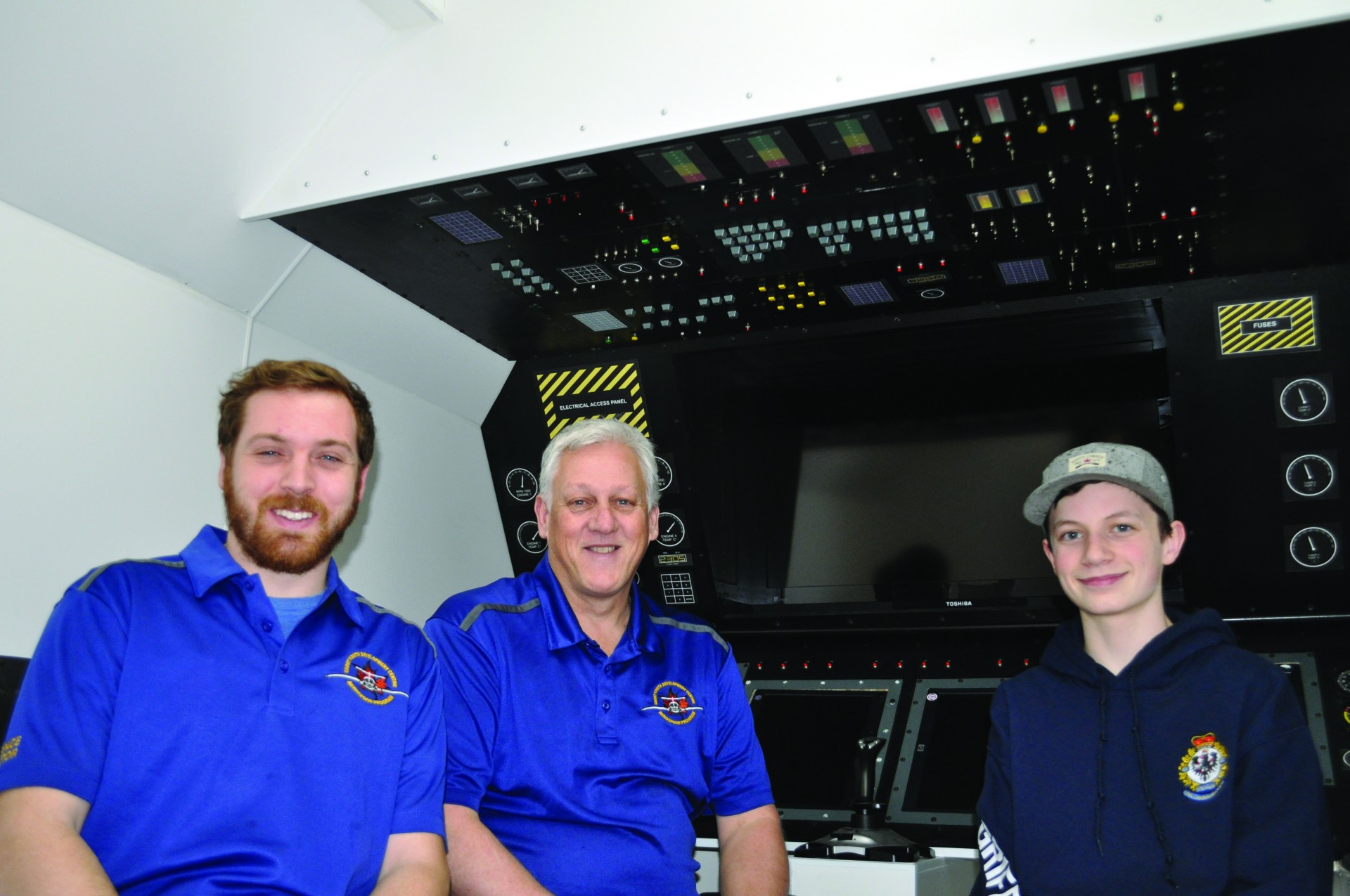

For News Tips & Advertising call...
Kitchener East - 519-578-8228
Kitchener West - 519-394-0335
CENTRE IS ONLY ONE OF ITS KIND IN CANADA
Cadet Youth Development Centre’s Aerospace
Program helps young people choose career paths
Cadet Youth Development Centre’s Aerospace
Program helps young people choose career paths
Aerospace program leaders Jesse Grubb (left), David Gowing, and cadet Odin Griffin sit in the nearly-completed cockpit of the centre’s True North space module simulator.
 By Carrie Debrone
By Carrie DebroneKitchener Citizen
February 11, 2016
What were your kids doing last night – watching TV, playing video games? Not these kids. Nope. They’ve made another choice.
They piloted Beechcraft / Raytheon Harvard II turboprop aircraft to 24,000 feet and did some aerobatics and formation flying.
They are Royal Canadian Air Cadets who are part of the Cadet Youth Development Centre’s (CYDC) aerospace program. Every Monday night they fly simulators at the centre located at the Waterloo Region International Airport in Breslau. The centre is the only one of its kind in Canada.
Located in a large building on the left hand side as you
enter the local airport off Fountain Street, the centre is home to about 100 cadets, aged 12 to 19, who meet weekly for range and drill team practices and parade nights that include classes in leadership, military history, band rehearsals and debating competitions.
About 35 of the Tutor 822 Squadron’s cadets are also part of the centre’s growing Aerospace Program, which offers basic to advanced aviation instruction, an aerospace engineering class, an aerospace science class, a computer programming class, and an aviation model building class. The centre recently received a $10,000 aircraft engine from a private donor, allowing the cadet’s aerospace program to be expanded this fall to include an aircraft mechanics and servicing class. All classes are offered free to registered cadets.
“We’re planting seeds. We’re youth farmers,” said retired Lieutenant Colonel Ron Gowing, who has been the centre’s director for eight years and has served in the Royal Canadian Air Force.
“It’s about helping kids to find out what they might like to do as a career. They can make their own intelligent choices, but no matter what they choose to do what we give them here will help them find a career path. The simulation program can empower them to take control of their future. It gives them self-confidence that they can excel in science, technology and math,” he said.
The 9,000-square-foot centre, which opened in 2004, has been entirely built with funds raised by volunteers. It includes offices for the air cadet squadron leaders, washrooms with showers, a canteen, supply storage and the large main “O’Drowsky Hall” named for Tom and Jane O’Drowsky of Waterloo, who were both commanding officers when the 822 Squadron was first founded in 1972.
The aerospace program is run solely by volunteers, many of who are retired military or commercial pilots, and some who are former cadets.
David Gowing (Ron’s son), who is also a volunteer with the aerospace program, is currently spearheading efforts to construct a space vehicle simulator at the centre. Named “True North”, the module is currently under construction at the back wall of the centre. It will simulate a space vehicle with a cockpit set up similar to that of the NASA shuttle or the space station with a command centre, an aerospace engineering section, satellite repair station, medical lab and a life science centre where growth chambers for lettuce and tomatoes will be set up and cadets can perform water filtration and air quality experiments.
Expected to be completed in about two years, the space module will simulate a mission to Mars and will include a station where cadets can build space probes and launch them. The first components for the module simulator were donated by VIG Computers in Cambridge.
“We are really hoping that we can get some of KW’s aerospace industries to partner with us on this project. Our program is a STEM program (Science, Technology, Engineering and Math) and it will help Canada’s aerospace industry by allowing kids the opportunity to see what jobs there are available in that field,” Gowing said.
Three years ago the centre received a digital flying simulation program that was developed and donated by the global aerospace firm Lockheed Martin. Based on a game-based flight simulator, the Prepar3D simulator provides a virtual reality platform that incorporates immersive learning scenarios from simulated underwater to suborbital space environments. The technology is currently in use by both military and civilian professionals for individual and group training exercises.
Not only does the CYDC program introduce the cadets to new technology used in current and future career fields, it also attempts to recruit the best professional volunteers it can find to teach its aerospace classes.
“That’s part of our secret to success,” Gowing said.
“We have attracted top notch people and we make it fun for them to be here too.”
Volunteer Jeff Neely, a retired commercial airline pilot, teaches the advanced aviation program.
“This is the highlight of my week to come in and work with these kids,” Neely said, adding that the aerospace flying course is challenging and can at times be “more taxing than a whole eight hours at school.”
“After they finish our flying courses (which takes about four years from basic to advanced) I would feel confident that they could keep the aircraft in the air should something happen to the pilot and that they could land the aircraft by being talked down,” he said.
Neely added that if a cadet decided to become a licensed pilot as a career, the training provided in the aerospace program is “a great background” allowing them to come into subsequent flying programs with more training and confidence.
Cadet Curtis Steinmann, who graduated from the advanced flying program, went on to earn his glider pilot license and is now working on his power wings. He now helps teach younger cadets and hopes to become an air force pilot.
Cadet Odin Griffin, who is in the advanced aviation program, said he believes the program has helped him succeed at school.
“You learn to pay more attention to things and it’s helped me with math,” Griffin said.
The Centre’s Assistant Director, Jesse Grubb, is a former cadet.
“These kids are so smart. I’m jealous that we didn’t have some of these current programs when I was in cadets,” he said.
Grubb said the centre is also constantly experimenting with different space science classes. For example, he is now designing an unmanned vehicle class that will be taught by a Waterloo Regional police officer.
“At 12 years old our education system is asking our kids to decide on a career path. Our programs allow them to think about what they could do with their lives. It’s got nothing to do with becoming a pilot,” Gowing said.
* * *
The centre offers its programs to local schools, Guides and Scouts and community groups as well as to other cadet squadrons from across Ontario. It also invites youngsters to a Girls Can Fly day on March 5, 2016. Sponsored by the WW Flight Centre, admission is free. The event will promote the opportunities for women and girls to seek a career in aviation. Displays will be set up in the Flight Centre’s hangar at the Region of Waterloo International Airport. The CYDC will be there with its full panel Cessna 172 flight simulator, UAV’s and robotics. Girls can register on the WW Flight Centre website for a free flight.